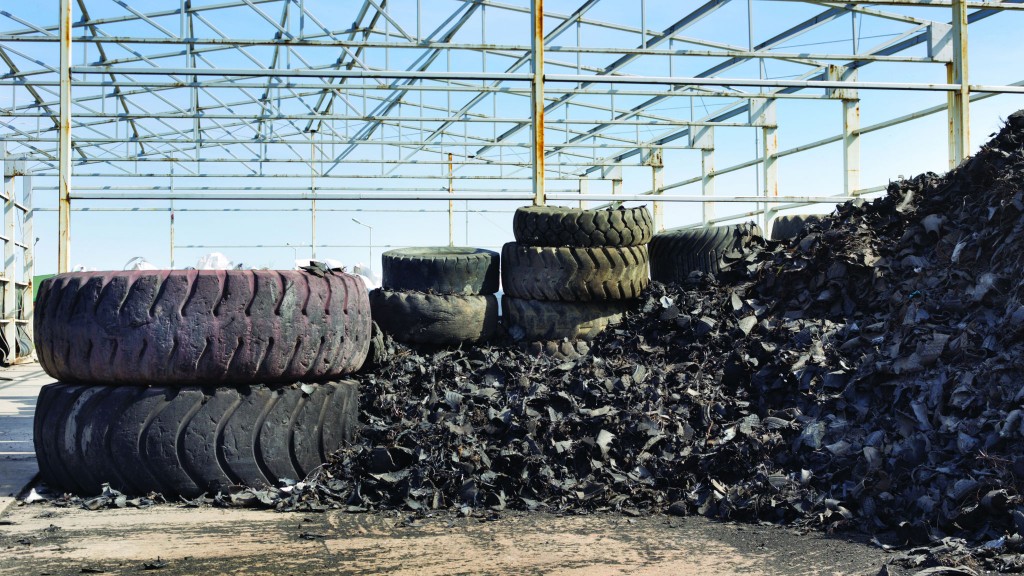
Recycling aluminum cans, plastic bottles and paper is almost second nature to most North Americans. But for some reason the same mindset doesn't apply to recycling tires. The four wheels that make it possible for so many of us to function on a daily basis are creating a massive environmental dilemma.
Over the last 20 years, Canada has steadily invested in new research and technology to build up its tire recycling infrastructure. In 2018, over 487,000 tons of end-of-life tires were recycled or recovered, approximately 60 percent of the tires collected across the country.
According to the EPA, around 1.7 million tons of tires were recycled in the U.S. in 2018, which is approximately 40 percent of the total amount of rubber in tires generated that year. Unlike the data from the Canadian Association of Tire Recycling Agencies (CATRA), the U.S. recycling estimates do not include retreaded tires or energy recovery from tires.
Over the last 100 years, billions of tires have accumulated in "tire mountains" and more than 1 billion end-of-life tires are added every year. Without a scalable recycling solution, the volume of tires will continue to grow, and end-of-life markets are not able to keep up with the volume of scrap tires that are being generated, according to a report by the U.S. Tire Manufacturers Association.
Understanding these sobering statistics is not enough. Let's explore why tire recycling has failed to keep up with tire waste, and how as an industry we can begin to think about truly scalable solutions.
What's So Difficult About Recycling Tires?
There are several factors that make recycling tires a challenging endeavor:
● The large size and hollow shape of tires creates problems. Rubber tires are heavy and hefty to transport. When they are sent to a landfill, it can take 50 to 80 years for just one tire to decompose. Once they sit there and begin to break down, hazardous fumes are emitted along with heat. Many of these "tire mountains" become havens for trapped mice and mosquitoes to breed.
● Laws are inconsistent in regulating end-of-life tires. While some U.S. states have made immense progress over the last 20 years to regulate tire recycling, it varies. Without uniform laws in place, some states have less funding and worse waste issues than others.
● Tire waste is growing unchecked. In countries like India and China, the middle class is growing, and more people have the ability to purchase cars, which wasn't a possibility decades ago. These countries are accumulating waste tires at a faster rate than ever before.
● Commercial recycling plants are sparse. Worldwide, there are thousands of tire shredders that recycle tires into chips and shreds, but the machines are large and expensive. Then, transporting those shreds to facilities to be recycled is a logistical nightmare. The fact is that there is no technology that currently exists to make tires worth recycling on a massive scale.
● Instead of being recycled, many end-of-life tires are currently burnt. It's well documented that burning old tires emits dangerous fumes and pollutes the air. The fumes are a threat to the environment as well as human health — studies show they can cause heart disease and cancer, especially for the individuals who work at these plants.
Potential tire recycling solutions
Witnessing the stockpile fires that happened in the 1980s here in northeastern Ohio and diving deeply into more recent research around the environmental and health issues mentioned above motivated our teams to begin thinking about a truly scalable tire recycling solution — and we want to inspire the industry to begin thinking the same way. The EPA estimates there are more than 110 products made out of material that comes from recycled tires, but much of this is from the actual tire shreds, such as playground mulch, walkways and crumb rubber.
We started exploring technology that could help transform the billions of end-of-life tires into viable byproducts. There's potential to convert old tires into carbon black, oil and gas — which can later be used to create diesel fuel, toner cartridges, asphalt and electric car batteries. Nanocarbons are needed to create electric car batteries, so utilizing tires to create these in-demand products can make an incredible environmental impact. Creating a tire recycling product with a viable byproduct would be good for business, creating a revenue stream that is virtually nonexistent now.
Ohio-based Lubrication Specialties, Inc. (LSI) is motivated to develop a viable solution that is agile and mobile to effectively overcome many of the existing obstacles that exist in tire recycling. In order to catch up to the end-of-life tires that exist in landfills today, tire recycling needs to change dramatically — the status quo isn't even making a dent.
About the author: Chris Gabrelcik, founder and CEO of Lubrication Specialties, Inc. (LSI), is one of a select few in the entire world that holds both titles of Certified Lubrication Specialist (CLS) and Oil Management Analyst (OMA). He is also a member of the Society of Tribologists and Lubrication Engineers (STLE), and Association of Diesel Specialists (ADS). He attends annual STLE and ADS conferences to remain informed on the latest scientific advances and studies available to the industry. He began Lubrication Specialties, Inc. in 1997, and since the development of Hot Shot's Secret THE ORIGINAL STICTION ELIMINATOR in 2004, his company has grown rapidly and continues to do so as he strives to bring forward the highest quality products possible to his customers.
Also visit: https://etracks.ca/


